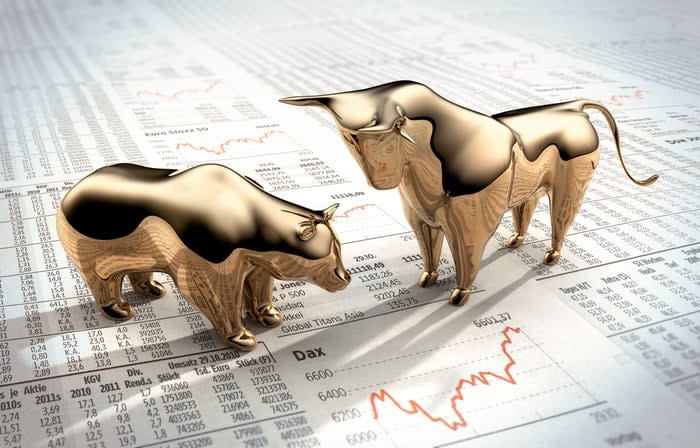Here's the Average Stock Market Return Over the Last 10 Years, and What Investors Can Expect Over the Next 10 Years
Investing in the stock market is one of the best ways to grow your wealth over the long run. Investing doesn't have to be complicated, either. One of the best investing strategies is to buy a low-cost index fund and call it a day.
It's natural to look to history to try to figure out what to expect going forward. Even though we've experienced two bear markets in the last 10 years, the history of the S&P 500 -- the most commonly used index for referencing "the stock market" -- paints a promising picture. Stock market returns have been stronger in recent years, on average, than in the distant past.
Investors may be wondering whether the strong returns of the past decade are here to stay, or whether returns may become more muted going forward. In that regard, taking in the context of the last 10 years, and the overall history of the stock market, can be informative.

Image source: Getty Images.
Here's the average stock market return for the last 10 years
The last 10 years include bear markets in 2020 and 2022 (when the S&P 500 fell 20% or more). We also barely avoided a 20% decline in 2018. Despite three major setbacks, stocks proved extremely resilient.
Since mid-2014, the S&P 500 has produced a total return of 233.6%. That's the equivalent of compounding at a 12.8% annualized rate. Here's how it breaks down by year.
Year | Annual Return of the S&P 500 (Including Dividends) |
|---|---|
2014* | 5.46% |
2015 | 1.38% |
2016 | 11.96% |
2017 | 21.83% |
2018 | -4.38% |
2019 | 31.49% |
2020 | 18.40% |
2021 | 28.71% |
2022 | -18.11% |
2023 | 26.29% |
2024** | 15.44% |
*Beginning July 30, 2014. **Ending July 30, 2024. Data source: YCharts.
Investors know that the stock market doesn't go up in a straight line. Volatility is par for the course when investing in stocks, and some years will be better than others. But the last 10 years have produced significantly more up years than down years -- more than the historical average.
As you can see, there have only been two years out of the last 10 when the market finished lower than it started. Even though we saw a huge drop in stock prices at the onset of the COVID-19 pandemic in 2020, stocks recovered quickly. Even the prolonged bear market of 2022 saw a swift recovery in 2023, setting new all-time highs in early 2024.
The recent stock market returns have remained above average, although not too far above average. The strong results could be explained by friendlier monetary policies from the Federal Reserve following the Great Recession, or by changes in market behavior.
It's important to remember that you should always look forward, not backward, when making an investment. While history can be a guide, investors may need additional context to figure out what to expect going forward.
One expert weighs in
The returns of the last 10 years have been spectacular. Even when you factor in inflation, which has surged over the past few years, real returns for the S&P 500 averaged around 8.9% per year compounded. That's well above the historical average of the S&P 500, which is around 6.9%.
Going forward, there's reason to expect a reversion to the mean instead of the continued high performance. Professor Jeremy Siegel, author of Stocks for the Long Run, explains it simply.
"The price/earnings ratio of the market probably should be around 20, which is pretty close to where it is today," he said in a recent interview with Barron's. "As the P/E drifts upward, forward-looking returns have to be muted a bit."
As of this writing, the S&P 500 sported a forward P/E ratio of 20.6. As a result, Siegel expects average inflation-adjusted returns of between 5% and 5.5% from the S&P 500 over the next 10 years.
That said, the S&P 500 can climb to much higher valuations, as it has in the past. However, valuations significantly higher than today's that last for a sustained period have historically led to big stock market declines eventually. Siegel's forecast isn't calling for another big drop in stocks (although history suggests we'll likely see another bear market in the next decade). Rather, he expects the average returns to be a bit lower than average after a decade of strong performance.
Importantly, Siegel's forecast doesn't conflict with his position on investing in stocks for the long run. He still suggests that investing in stocks over any other asset class is the best way to build wealth over the long run.
Don’t miss this second chance at a potentially lucrative opportunity
Ever feel like you missed the boat in buying the most successful stocks? Then you’ll want to hear this.
On rare occasions, our expert team of analysts issues a “Double Down” stock recommendation for companies that they think are about to pop. If you’re worried you’ve already missed your chance to invest, now is the best time to buy before it’s too late. And the numbers speak for themselves:
Amazon: if you invested $1,000 when we doubled down in 2010, you’d have $18,910!*
Apple: if you invested $1,000 when we doubled down in 2008, you’d have $41,544!*
Netflix: if you invested $1,000 when we doubled down in 2004, you’d have $330,931!*
Right now, we’re issuing “Double Down” alerts for three incredible companies, and there may not be another chance like this anytime soon.
*Stock Advisor returns as of July 29, 2024
The Motley Fool has a disclosure policy.
